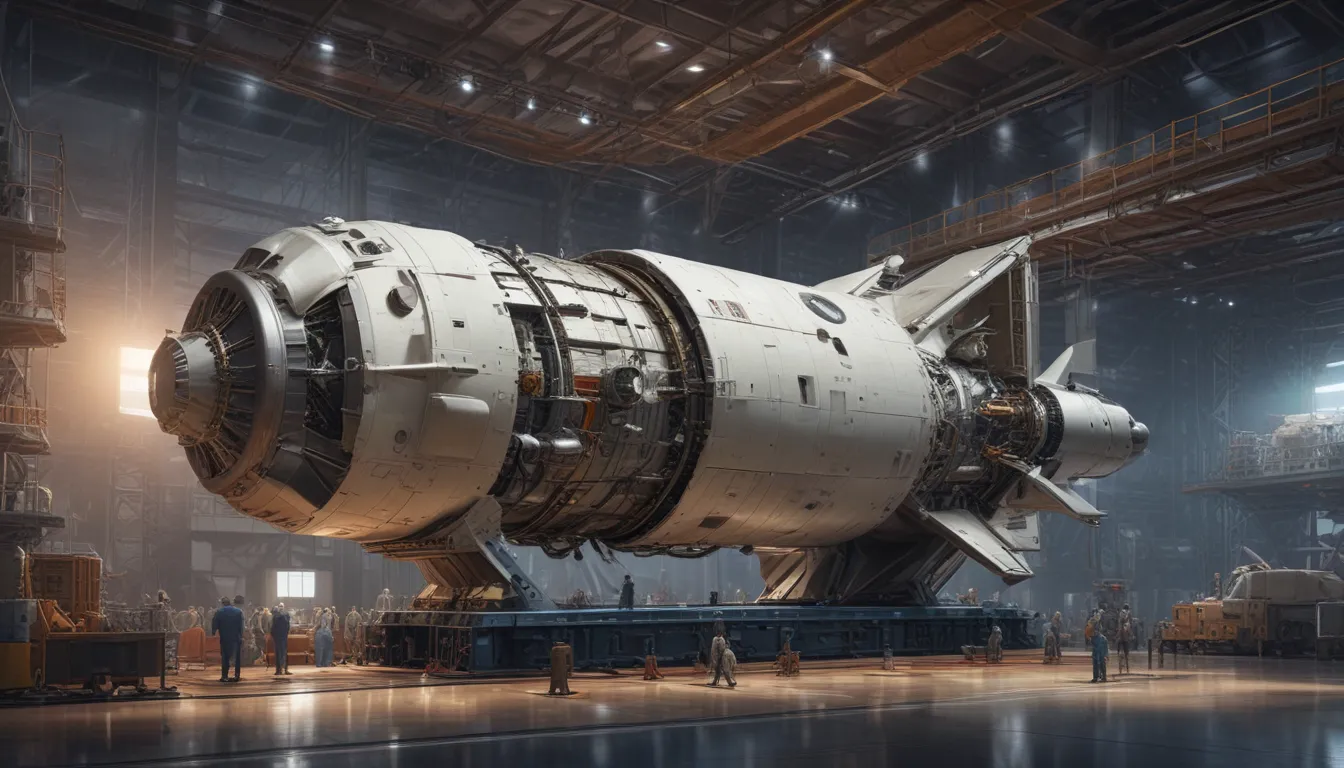A Note About Images: The images used in our articles are for illustration purposes only and may not exactly match the content. They are meant to engage readers, but the text should be relied upon for accurate information.
Welcome to the fascinating world of the NASA Vehicle Assembly Building (VAB) at Kennedy Space Center, a structure that has been at the forefront of the United States’ space exploration journey. In this article, we will embark on a journey to explore 19 intriguing facts about the VAB, diving into its rich history, remarkable construction, and enduring legacy in space exploration. Join us as we unravel the untold story behind this magnificent engineering marvel and discover the awe-inspiring details that make the VAB an integral part of NASA’s spacefaring heritage.
Unveiling the Marvel: Key Takeaways
- The VAB, one of the world’s largest buildings, serves as the birthplace of rockets for space missions and has been graced by the presence of four American presidents.
- A symbol of human innovation and collaboration in space exploration, the VAB inspires future generations to reach for the stars and unlock the mysteries of the cosmos.
The VAB: A Towering Engineering Marvel
Standing tall at 526 feet, the Vehicle Assembly Building at NASA’s Kennedy Space Center is a monumental engineering feat and ranks among the largest buildings globally. Constructed in the 1960s to support the Apollo program, the VAB has since become a vital facility for assembling and processing rockets for a myriad of space missions.
Presidents Under the VAB’s Roof
The VAB has welcomed four American presidents, namely Richard Nixon, Bill Clinton, George W. Bush, and Barack Obama, underscoring its role as a symbol of American innovation and space exploration. These presidential visits highlight the VAB’s significance in the nation’s journey through the cosmos.
A Flag of Monumental Proportions
Adorning the side of the VAB is an American flag that spans an impressive 209 feet by 110 feet, equivalent to the size of a basketball court. This iconic flag symbolizes NASA’s unwavering dedication to space exploration and patriotic pride.
Doors Fit for Giants
The VAB proudly hosts some of the largest doors globally, towering at 456 feet in height and taking approximately 45 minutes to fully open or close. These colossal doors play a crucial role in facilitating the movement of assembled rockets in and out of the building.
Braving the Storms: Resilience Personified
Designed to withstand hurricane-force winds of up to 125 miles per hour, the VAB is an epitome of resilience. This exceptional durability ensures the protection of valuable equipment and spacecraft housed within the building during adverse weather conditions.
Birthplace of Saturn V Rockets
Initially tailored for the assembly of the mighty Saturn V rockets utilized in the Apollo and Skylab programs, the VAB was deliberately constructed to accommodate these colossal launch vehicles. Its vast size was a necessity to house these monumental rockets.
A Cathedral of Space Exploration
Boasting an immense interior volume of 129,428,000 cubic feet, the VAB stands as one of the largest single-story buildings globally. This expanse allows for the simultaneous processing of multiple spacecraft and launch vehicles, making it a hub of space mission preparations.
Building Blocks of the VAB
The construction of the VAB was a Herculean task that consumed staggering quantities of materials. It entailed 98,590 tons of steel, 65,000 cubic yards of concrete, and 71,000 square feet of glass, reflecting the monumental scale of this engineering masterpiece.
Roofing in Style: The Meatball Insignia
The VAB’s roof features the iconic NASA insignia, affectionately known as the “meatball,” spanning 110 feet in diameter. This recognizable symbol pays homage to the building’s integral role in NASA’s ambitious space exploration missions.
A Technological Metamorphosis: SLS Revamp
In preparation for the Space Launch System (SLS) missions, the VAB underwent extensive renovations aimed at modernizing its infrastructure and processing capabilities. These upgrades were crucial in supporting the integration of the next generation of space vehicles.
Pathway to the Stars: The Crawlerway
Connecting the VAB to the launch pads is a unique pathway called the “crawlerway,” paved with river rock and extending for 130 miles. This specially designed route facilitates the transportation of fully assembled rockets to the launch site, a vital component of space missions.
A Lunar Odyssey: The Artemis Program
As an integral part of NASA’s Artemis program, the VAB will play a central role in preparing the Space Launch System and Orion spacecraft for missions to the Moon and beyond. This marks an exciting new chapter in the VAB’s history of supporting space exploration endeavors.
Spectacular Views: Platform Panoramas
Visitors to the Kennedy Space Center can relish breathtaking views of the VAB from observation gantries, offering a unique perspective on the ongoing assembly and processing of space vehicles. These platforms provide an unforgettable experience for space enthusiasts.
Pioneering Human Spaceflight
Through its illustrious history, the VAB has been at the forefront of advancing human spaceflight, serving as the nucleus for assembling and launching iconic missions that have broadened our understanding of the universe and kindled the spirits of future explorers.
Sustainability at its Core
Aligned with NASA’s eco-friendly ethos, the VAB incorporates various environmental initiatives such as energy-efficient lighting, water conservation measures, and waste reduction programs to minimize its ecological footprint. This commitment underscores NASA’s dedication to sustainability.
A Global Nexus: International Harmony
The VAB has fostered international collaboration in space exploration, facilitating the integration of components from various countries to support joint missions and scientific endeavors beyond Earth’s atmosphere. This collaborative spirit underscores humanity’s collective quest for knowledge.
Legacy of Progress: Innovation Personified
As a beacon of innovation and human accomplishment, the VAB stands as a testament to the brilliance and perseverance of individuals who have contributed to NASA’s groundbreaking missions and the progress of space exploration. Its legacy continues to inspire generations.
Sparking Curiosity: Seeds of Exploration
Continuing to captivate audiences worldwide, the VAB ignites a sense of wonder and curiosity about the possibilities of space exploration and the uncharted frontiers awaiting humanity’s exploration. Its towering presence symbolizes the enduring spirit of exploration.
A Timeless Symbol: Enduring Inspiration
With its towering stature and rich history, the VAB encapsulates the enduring spirit of exploration and the relentless pursuit of knowledge, defining NASA’s mission to expand the horizons of space exploration for the betterment of humanity. It stands as a timeless symbol of human achievement.
In conclusion, the 19 captivating facts unveiled about NASA’s Vehicle Assembly Building illuminate the monumental achievements and engineering wonders associated with this iconic structure. From its colossal dimensions to its crucial role in space exploration, the VAB stands as a beacon of human innovation and ambition. As we forge ahead in our quest for space exploration, the VAB serves as a reminder of our unyielding pursuit of knowledge and discovery, inspiring future generations to reach for the stars.
Exploring Further: FAQs
-
What is the significance of the Vehicle Assembly Building?
The VAB serves as a crucial facility at NASA’s Kennedy Space Center for assembling and integrating rockets and spacecraft for space missions, playing a vital role in enabling exploration beyond Earth’s bounds. -
How tall is the Vehicle Assembly Building?
With a towering height of 526 feet, the VAB stands as one of the world’s largest single-story buildings, reflecting the grandeur of NASA’s ambitious space missions and the engineering marvels required to support them. -
What is the VAB’s role in space exploration?
As the primary hub for assembling and preparing spacecraft for launch, the VAB plays a pivotal role in facilitating NASA’s missions to explore space, conduct scientific research, and expand humanity’s cosmic horizons.
Embrace the Wonder
As we delve into the marvels of the NASA Vehicle Assembly Building, we uncover a world of innovation, collaboration, and endless possibilities in space exploration. The VAB embodies humanity’s relentless spirit of exploration and serves as a beacon of inspiration for all aspiring to reach new heights in the cosmos. Join us on this extraordinary journey of discovery as we continue to push the boundaries of space exploration, guided by the unwavering legacy of the VAB and the pioneers of human ingenuity.






